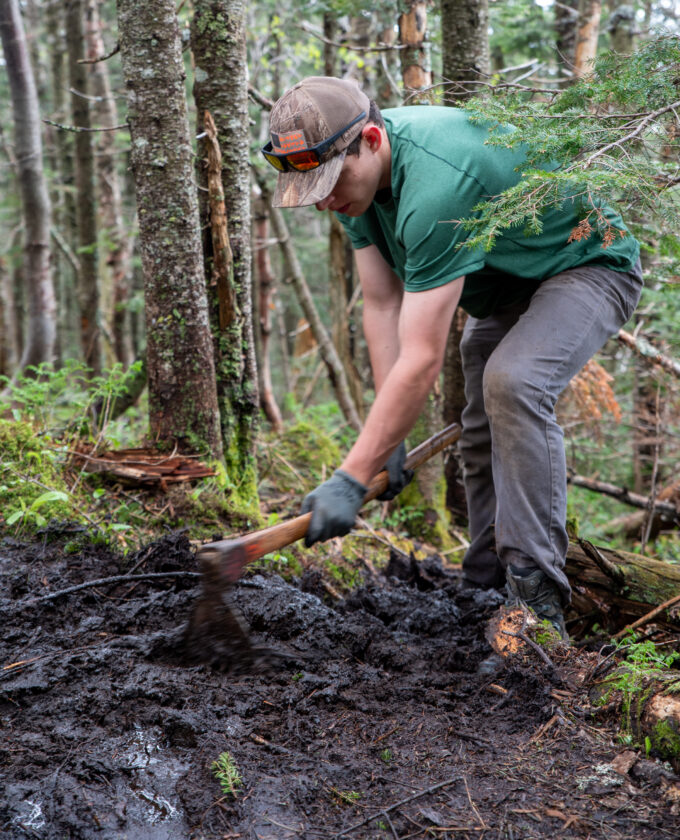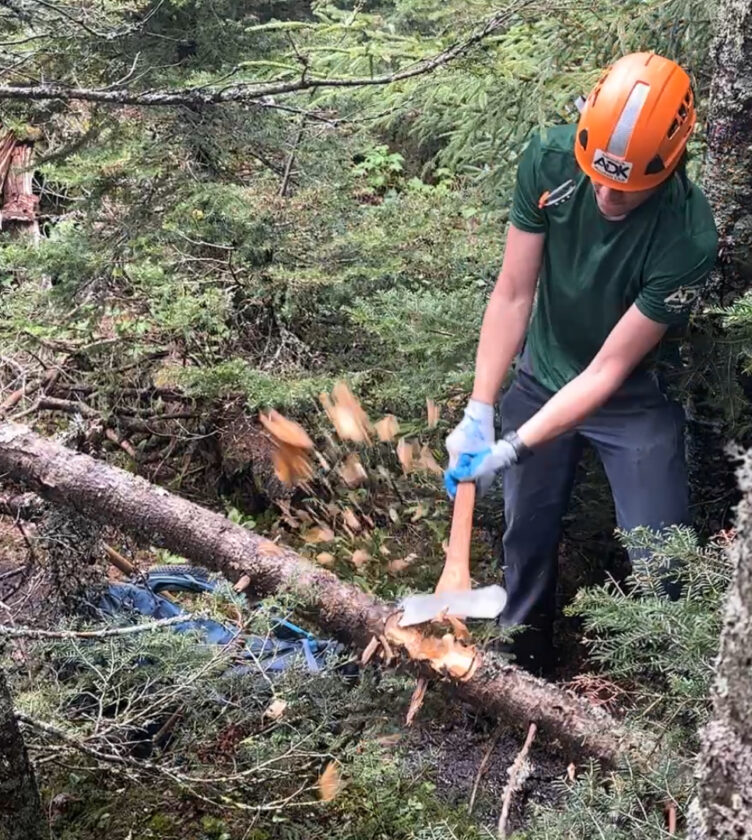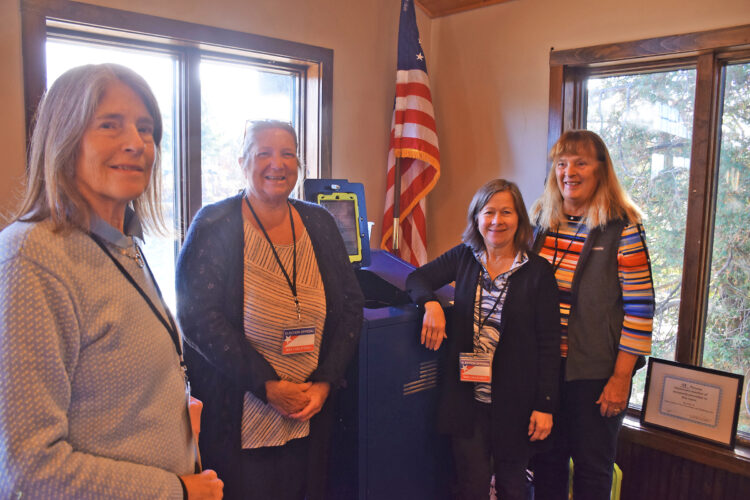ADK trail crews cap off 2025 season
- A member of the Adirondack Mountain Club’s professional trail crew clears a drainage on June 7, which happened to be National Trails Day, in the Johns Brook Valley in the town of Keene. (Provided photo — Kayla White)
- A member of the Adirondack Mountain Club’s professional trail chops away at a log on June 7, which happened to be National Trails Day, in the Johns Brook Valley in the town of Keene. (Provided photo — Kayla White)
- A member of the Adirondack Mountain Club’s professional trail chops away at a log on June 7, which happened to be National Trails Day, in the Johns Brook Valley in the town of Keene. (Provided photo — Kayla White)

A member of the Adirondack Mountain Club’s professional trail crew clears a drainage on June 7, which happened to be National Trails Day, in the Johns Brook Valley in the town of Keene. (Provided photo — Kayla White)
LAKE PLACID — When hiking in the Adirondacks, it often doesn’t take long to come upon a trail improvement, such as a switchback, a stone staircase or a well-defined drainage path directing running water away from the trail.
Collectively, these improvements are meant to both mitigate any environmental impact from the trail and enhance the experience for users. They are typically the result of back-breaking work. An improvement that can take mere seconds to walk over is often the result of days, weeks or even entire seasons.
This work is often done by teams of professional and volunteer trail crews that are affiliated with organizations tasked with stewarding Adirondack wild lands, such as the Adirondack Mountain Club (ADK) or the Adirondack 46ers — often working in close consultation with the state Department of Environmental Conservation to ensure that the projects conform with the various stringent environmental regulations in place on state wild lands.
Kayla White is ADK’s stewardship director. This year, she oversaw ADK’s trail crews, along with its Summit Stewardship Program. She said ADK has a strong partnership with the DEC and credited them for ensuring that trail work projects are identified, planned and carried out in a sustainable way.
“We couldn’t do it without DEC,” she said. “They’re the land manager and they do a really great job.”

A member of the Adirondack Mountain Club's professional trail chops away at a log on June 7, which happened to be National Trails Day, in the Johns Brook Valley in the town of Keene. (Provided photo — Kayla White)
Trail work is a year-round endeavor. While the field work itself is relegated to the warmer months, there’s a litany of off-season work that goes on to ensure that crews are ready to hit the ground running when the brief window of opportune weather presents itself.
ADK’s trail crews wrapped up their field work for the season in mid-August. This year, ADK hired 15 seasonal staff for the program — 13 members of a professional trail crew and two leaders to oversee volunteer trail crews.
The work was focused all throughout the park, with crews spending time in the High Peaks, Giant Mountain, West Canada Lake and Pigeon Lake wilderness areas, as well as the Johns Brook property, Debar Mountain Wild Forest, Elk Lake and Heart Lake areas.
In the High Peaks Wilderness area alone, trail crews removed at least 289 separate blowdowns along trails, according to a preliminary end-of-season report. ADK is expected to release its final report in the coming weeks. The professional trail crew is a full-time seasonal job, with its members logging 40 or more hours of work per week, either broken down into five 8-hour days or four 10-hour days, according to White. They camp out close to their projects — often several miles from the nearest trailhead — during the work week.
White said that trail crews often report the toughest part of the job is the pack-in. Given that they need to carry all of their tools, equipment, gear and food to sustain themselves for a week, it’s often an arduous process to figure out what to pack and how to pack it, and even with the best planning, it’s still often an extremely heavy weight load they are carrying — and the actual trail work hasn’t even begun.

A member of the Adirondack Mountain Club's professional trail chops away at a log on June 7, which happened to be National Trails Day, in the Johns Brook Valley in the town of Keene. (Provided photo — Kayla White)
That consists of moving large logs and heavy boulders across an uneven terrain, using gravity as a friend when possible and often engineering ingenious innovations if they’re working against it. Staying hydrated is easier said than done. Often, trail projects are a ways away from the nearest water source, especially this summer as dry weather has limited those — particularly at higher elevations.
White said a lot of trail crew members will say the best part of the job is that the work, as challenging as it can be, almost always has a tangible sense of progress.
The boots-on-the-ground presence during the summer is a major asset, not just for the trail work itself but also to provide conditions reports to the public or DEC as needed. White noted that this was especially pertinent in the wake of the July 14 mudslides around Mount Colden that impacted Avalanche Pass.
“(O)ur staff provided the Forest Rangers with information regarding the (landslides) immediately after it happened when DEC was getting ready to go in and scout the damage,” White wrote. “One of our trailhead stewards provided a video of the damage from a hiker and our summit steward on Algonquin took pictures of Colden so the rangers could see where the new slides were.”
The trail through Avalanche Pass remains closed to the public. The DEC is in charge of reopening the route and an agency spokesperson did not say there was a set timeframe for that yet.
“The trail remains closed to the public at this time,” a DEC spokesperson wrote on Monday, Sept. 15. “(DEC) staff are currently assessing conditions on the ground and evaluating various options for re-opening the trail. More information will be shared as it becomes available.”
With the active work season behind them, White said the focus is now on scouting new projects and developing work plans for those with the DEC to ensure their feasibility before pitching them to donors. She noted that the Adirondack 46ers have been a longtime trail work funder for ADK.
“Making sure that they have those work plans in place so when we’re fundraising, we have a nice list of projects that we can present to donors to get that funding,” she said.
She said a lot of state contracts for trail work also come up for bidding in the fall and early winter, so much of that time is spent figuring out if it’s a project that fits within ADK trail crews’ scope and capacity and, if so, putting together a competitive bid.
As the funding picture for the upcoming season becomes clearer throughout the winter, White said spring offers a final chance for pre-season scouting before the crews head out again for another season of trail improvements.
To learn more about ADK’s trail work, visit adk.org/trails-program.



